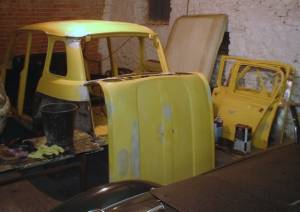I haven't attempted any oldtimer repairs yet myself, but I've noticed the complete lack of filler in the R4 repairs, unlike for example with this VW Beetle repair:
http://members.chello.nl/h.tillaart/restoroelfoto2.htm
http://members.chello.nl/h.tillaart/restoroelfoto3.htm
http://members.chello.nl/h.tillaart/restoroelfoto5.htm
With this stuff you can cover up quit a bit. Most of the work is creating a perfect steel piece and weld. So the more professional approach is to avoid using it as little as possible?
http://members.chello.nl/h.tillaart/restoroelfoto2.htm
http://members.chello.nl/h.tillaart/restoroelfoto3.htm
http://members.chello.nl/h.tillaart/restoroelfoto5.htm
With this stuff you can cover up quit a bit. Most of the work is creating a perfect steel piece and weld. So the more professional approach is to avoid using it as little as possible?





 but there's not much comment on the pictures. It just says they removed the rotten bits to weld in new steel. "Er is weer hard gewerkt!" = "Worked very hard again!" . And in part 5 they have finished the welding, the filler is used to cover up the new bits, they still need to sand the car, and put on a ground coat.
but there's not much comment on the pictures. It just says they removed the rotten bits to weld in new steel. "Er is weer hard gewerkt!" = "Worked very hard again!" . And in part 5 they have finished the welding, the filler is used to cover up the new bits, they still need to sand the car, and put on a ground coat.
 To me the very word filler conjours up images of overpriced, tarted-up old wrecks with shiny new paint and two-inch thick underseal lurking in the Gullible Fools Only pages of Autotrader... Sends shudders down the spine! Lead-loading is the way to go, although it does take more practice to get it right than slapping on a blob of filler.
To me the very word filler conjours up images of overpriced, tarted-up old wrecks with shiny new paint and two-inch thick underseal lurking in the Gullible Fools Only pages of Autotrader... Sends shudders down the spine! Lead-loading is the way to go, although it does take more practice to get it right than slapping on a blob of filler.